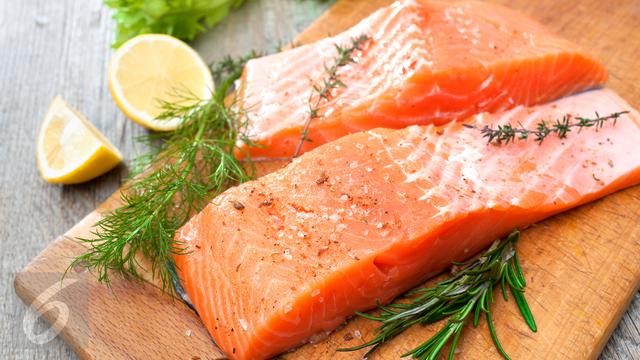Indonesia is one of the largest fish producing countries in the world. It is a consequence of the vast area of sea owned by Indonesia. One type of fish often caught in the Indonesian sea is from the scombroid group. The scombroid fish include tuna, mackerel, mahi-mahi, bluefish, and sardines. The high consumption of fish in the community makes people consider and monitor the quality of fish meat.
Scombroid group fish meat is known to contain histidine amino acids. After the fishing process and during storage, histidine may turn into histamine through an enzymatic process because of the action of bacteria that have decarboxylase histidine activity (histidine decarboxylase positive). This process occurs 6 hours after the death of fish at 25-38 o C temperature. This process can be inhibited by storing fish at temperatures below four o C or by adding bacteriocins from lactic acid bacteria which are used as starters during the fermentation process.
According to the Indonesian National Standard (SNI) number 01-2360 in 2008, the maximum content of histamine in fish meat allowed is 100 mg/kg. The European Commission has made regulations to determine the quality of seafood based on its histamine content, good quality if the histamine level is lower than 10 mg/kg, 30 mg/kg means it starts to decline in quality and higher than 50 mg/kg is strong evidence of damaged fish meat. While US food and drug administration set the fish meat in good quality well if the histamine content is lower than 50 mg/kg. In general, fish meat is suitable for consumption if the histamine content is lower than 50 mg/kg, it starts to turn toxic when it reaches 100 to 200 mg/kg and higher than 1000 mg/kg is toxic and not suitable for consumption. Therefore, it is necessary to develop an easy, fast, and accurate method to determine the quality of fish meat, especially based on its histamine content.
Various methods have been developed to determine histamine content, including ultrasensitive electrochemical flow injection, lignin modified glassy carbon electrode, thin layer chromatography, high performance liquid chromatography (HPLC), nuclear magnetic resonance (NMR), electrochemiluminescence, liquid chromatography-mass spectrometry (LC-MS), polymerase chain reaction / denaturing gradient gel electrophoresis (PCR-DGGE) and spectrophotometry. But these methods require expensive instruments and require special skills. A chemical reaction is one way that can be done to show the presence of certain substances in a sample, including histamine content in fish meat.
The characteristics of a chemical reaction include the formation of color. For example, ingredients containing borax will turn orange-red when it is dripped with turmeric juice in an acidic atmosphere. The results of previous researches stated that alizarin red S (ARS) could react with metal ions and organic compounds to produce new colored compound and the color is different from the color of ARS, metal ions and organic compounds. Based on this fact, research has been carried out to use ARS and copper metal ions (Cu 2+) to detect histamine content in fish meat.
The results showed that ARS react with copper and histamine metal ions to produce complex purple compounds. The formation of this complex compound is influenced by several factors, including pH, ARS concentration, copper metal ion concentration, and reaction time. The optimum condition of the reaction is at pH 6, the concentration of ARS is 50 ppm, the concentration of copper metal ion is 50 ppm, and the reaction lasts for 10 minutes. This histamine detection method can be used to detect histamine content to 9 ppm concentration (9 mg/kg). It is still far below the histamine threshold in fish meat recommended by SNI, which is lower than 100 mg/kg.
This histamine detection method has been applied to determine histamine content in fish meat with a confidence level of more than 99%. In general, it can be concluded that the quality of scombroid fish is determined by the histamine content in the meat. The histamine content in fish meat can be determined by chemical reactions with ARS and copper metal ions. Positive results are indicated by discoloration of fish flesh to purple if it is dripped with ARS and copper metal ions. The perfection of the reaction is influenced by pH, ARS concentration, copper metal ion concentration, and reaction time. The optimum condition of the reaction is at pH 6, the concentration of ARS is 50 ppm, the concentration of copper metal ion is 50 ppm, and the reaction lasts for 10 minutes.
Author: Dr. rer. nat.Ganden Supriyanto, Dipl. EST, M.Sc
Related link: http://www.ukm.my/mjas/v23_n3/pdf/Jannatin_23_3_15.pdf
This popular scientific article is extracted from article published in Q4 international journal by: Miftakhul Jannatin, Ayu Nabila Izazi Latjuba, Sri Wahyuni, Ganden Supriyanto, Wan Aini Wan Ibrahim, Rapid Spectrophotometric Method for Histamine Determinationin Red S and Metal Fish Using Alizarin, Malaysian Journal of Analytical Sciences, volume 23, number 3 (2019) 505-515





